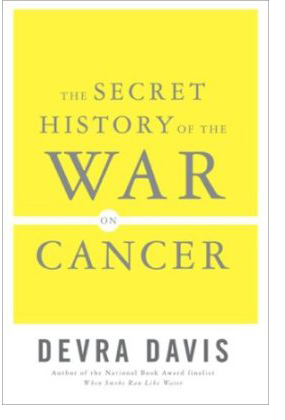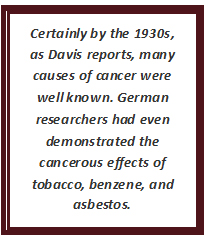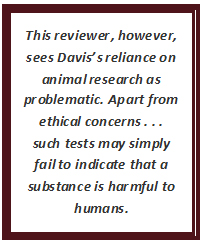 Review: Devra Davis, The Secret History of the War on Cancer
Review: Devra Davis, The Secret History of the War on Cancer
About a year ago, I participated in a phone survey concerning Canadian health issues. One question asked me to determine which should be the greater priority for the federal government: preventing heart disease or treating cancer?
I asked the pollster why the prevention of cancer was not an option. ?How do you prevent cancer?? she asked, through her laughter. Well, eliminating exposure to cigarette smoke, asbestos, benzene, pesticides, and herbicides were just a few examples that I immediately provided.
Clearly, however, the researcher?hired by no less than one of Canada’s most powerful political parties?had simply swallowed whole the false assumption that we are helpless to stop new cases of cancer from developing. More disturbing, though, is that one of our country’s major political players obviously gives little thought to the known carcinogens (to say nothing of the suspected carcinogens) in our air, water, land, food, and workplaces.
How did it come to pass that our society simply accepts cancer as the inevitable cost for living longer than previous generations? How has industry (with government complicity) managed to obscure the cancer risks to which we are being exposed?
In The Secret History of the War on Cancer, epidemiologist Devra Davis shows us how industries that use and produce carcinogens have concealed risks, funded self-serving studies, influenced politicians, sat on the boards of anti-cancer agencies, and exploited any doubts about the carcinogenic potential of products and employees? working conditions. She portrays the struggles of individuals who risked litigation, loss of research funding, and even career suicide to bring attention to this dismal situation.
A central theme of Davis’s book is the potent strategy of creating doubt, first developed by the tobacco industry and taken up later by the chemical industry, to dismiss concerns about the health effects of their products. (The ?doubt? about the potential of chemicals to cause harm makes it acceptable to expose our children to cancer risks, even by people who are considered to be educators: my local school board has no problem using potential carcinogens around its playgrounds, because these chemicals have not yet been ?proven? to cause cancer). The tactic of creating doubt is now even used to discredit the accumulated evidence for evolutionary theory and the threat of global warming.
Davis draws upon industry records, epidemiological research, and her considerable professional experience. Not only does she delve into controversies about cancer statistics, research, detection, and prevention, she provides her own personal experiences of losing friends and family members to cancer.
 The book also includes a fascinating history of medicine’s knowledge of carcinogens. By 1700, Bernardino Ramazzini, an Italian physician, had already discovered that cancer was an occupational risk in several professions.
The book also includes a fascinating history of medicine’s knowledge of carcinogens. By 1700, Bernardino Ramazzini, an Italian physician, had already discovered that cancer was an occupational risk in several professions.
Later that century, Percival Pott, an English surgeon, determined that scrotal cancer was an occupational hazard among chimney sweeps. Certainly by the 1930s, as Davis reports, many causes of cancer were well known. German researchers had even demonstrated the cancerous effects of tobacco, benzene, and asbestos. (Later, after Germany’s defeat in the Second World War, governments and industry snapped up Nazi scientists, pilfered their research, but concealed or discredited the Nazi research on carcinogens).
Davis quickly dispels the myth that increases in the rate of cancer can simply be explained as the cost of living longer. Why, for example, is brain cancer five times more prevalent in the U.S. as compared to Japan? Why, in a single decade, has testicular cancer increased by 50 per cent in men less than 40 years of age? Why are younger women experiencing twice the rate of breast cancer seen in women of the same age a couple of generations ago? Why are black women more likely than white women to become victims of breast cancer? And an aging population definitely has nothing to do with the rise in leukemia and other cancers among children.
Financial concerns are of course the principal motive for hiding or minimizing the causes of cancer, and for failing to clean up toxic land. Racism has also been a factor, and in the U.S., higher rates of cancer among blacks were often blamed upon genetic differences rather than the dirty and dangerous occupations in which they have worked.
North American society is awash in known and potential carcinogens (including the hormone disruptors that many people inadvertently ingest or apply to their bodies on a daily basis) but industry has been allowed to create this situation because governments in the U.S. and Canada have failed to enact and enforce laws that ensure workplace safety and limit consumers? exposure to carcinogens.
The Reagan era in the U.S. was particularly regressive, as it pursued a program of less government control, and therefore had little interest in monitoring carcinogenic substances. The legacy of this free-for-all mentality continues to this day, and Canada’s situation is not very different: while the European Union has banned many potentially harmful substances from personal care items, for example, these same chemicals can be found in North American products, including bubble baths and shampoos for babies.
(Davis’s book was published before baby bottles containing BPA were removed from store shelves in Canada, but the BPA issue illustrates the government’s failure to seriously limit the public’s exposure to potential carcinogens. Ostensibly protecting cuddly babies from carcinogens makes for good public relations, but BPA is still being used in reusable water bottles and by the food industry to line tin cans.)
In terms of Canadian relevance, Sarnia, Ontario, earns special mention. Davis portrays it?owing to the effects of the asbestos industry?as a cancer hotspot. Though asbestos is banned in many countries, Canada continues to mine and produce the carcinogen.
Individuals victimized by cancer may also find themselves victimized by the legal system. Legal manoeuvring makes it almost impossible to sue corporations that use and produce carcinogens. According to Davis, ?before you can collect damages, you must . . . show that someone already got [cancer] from the same things you did, prove that you had specific exposures to a particular agent, find the firm that caused your harm . . . and prove that they knew the exposure was harmful? (42-3).
 In effect, the legal standard for proof of harm is impossibly high. According to Davis, even though, as mentioned above, it was known in the 1700s that chimney sweeps were subject to scrotal cancer, a modern-day chimney sweep who develops this disease would be unable to sue an employer, as it would be impossible to determine which single carcinogen, among the hundred or so carcinogens found in soot, actually caused his particular cancer.
In effect, the legal standard for proof of harm is impossibly high. According to Davis, even though, as mentioned above, it was known in the 1700s that chimney sweeps were subject to scrotal cancer, a modern-day chimney sweep who develops this disease would be unable to sue an employer, as it would be impossible to determine which single carcinogen, among the hundred or so carcinogens found in soot, actually caused his particular cancer.
Davis uses epidemiological and animal research in helping to determine which substances are likely to produce cancer in humans. She also highlights a legal double standard in the application of animal studies: they are acceptable for testing the safety of pharmaceuticals that are later used on humans, but are not accepted as proof of harm in the case of carcinogens. Even though substances may cause cancers in rats, for example, governments, industry, and the courts do not consider it to be proof that humans may be at risk.
This reviewer, however, sees Davis’s reliance on animal research as problematic. Apart from ethical concerns (animals are supposedly different enough from us that we can subject them to whatever tests we wish, but similar enough to us that animal research findings are applicable to humans) such tests may simply fail to indicate that a substance is harmful to humans.
The Canadian Coalition for Health and the Environment, for example, questions the value of animal tests that study exposures to single chemicals in isolation, under completely artificial conditions. In an open letter regarding the testing of herbicides, they cite findings suggesting that rats, the favoured species for laboratory tests, actually have an innate protection from some substances that are harmful to humans: ?extrapolation from studies in rats may be inappropriate, because rats have genes that do not exist in people, for detoxification of chemicals.?
Davis herself makes reference to erroneous tobacco research on rats that failed to produce cancer in the animals (and was thus cited by the tobacco industry as proof of its product’s safety) simply because the physiology of the rat respiratory system was not taken into account. Are we, perhaps, allowing ourselves to be exposed to substances that produce cancers in humans because they failed to do so in animals? This points to the need for a much more sensitive measure of safety; cell cultures, perhaps?
Nevertheless, Davis presents us with issues that should be a call to action. In preventing cancers, we need to demand more accountability and openness from industry, better regulation and enforcement by government, and willingness by both entities to clean up toxic waste sites.
In addition, she underlines the need for an independent and objective body to research cancer risks (though, I must add, one which does not rely upon inappropriate and outdated animal studies).
Well written, engaging, and drawing upon a vast amount of personal and professional knowledge, The Secret History of the War on Cancer is a must-read for anyone concerned about human health and the health of the planet.
The Secret History of the War on Cancer is published by Basic Books. ISBN-13: 978-0-465-01566-5. ISBN-10: 0-465-01566-2.

